BIO101 Exam 4
1/163
Earn XP
Description and Tags
ecology & evolution, microevolution,
Name | Mastery | Learn | Test | Matching | Spaced |
|---|
No study sessions yet.
164 Terms
microevolution
change in allele frequency from one generation to the next in a population
acts on phenotypes, requires change in genotype
mechanisms of microevolution
genetic drift: chance events lead to change in allele frequency unpredictably (founder effect, bottleneck effect, human action)
gene flow: genetic exchange due to migration between populations
mutation: a random change in DNA
natural selection
gene flow
genetic exchange due to the migration of fertile individuals/gametes between populations
DECREASES differences between populations and INCREASES genetic diversity within a population
can actually decrease fitness of receiving population in some cases (specific adaptations might not work in a diff environment) (or increase fitness)
can maintain alleles in a population, even if it’s disadvantageous and selected against
mutation
random change in nucleotide sequence of DNA in an individual - point mutation (change in single base pair)
causes: errors in replication, radiation exposure, certain chemicals
must be heritable to alter allele frequency and lead to evolution
more often bad than good, organisms are typically already well-suited to their environments
negative mutations often removed quickly by natural selection, positive ones may be selected for
rate of change depends on generation time (rapid in microbes and viruses, slower in animals)
neutral variation
no advantage of disadvantage for survival/reproduction; most mutations are neutral (happen in non-coding regions of DNA, don’t cause change in amino acid sequence)
natural selection
accumulates and maintains favorable genotypes in a population - eneds genetic variation
modes of natural selection
directional selection: favors individuals at one extreme of a phenotypic distribution (other extreme experience poor reproductive success)
disruptive selection: favors individuals with (both) extreme phenotypes (individuals w/ intermediate values of a trait have poor reproductive success)
stabilizing selection: favors individuals with intermediate phenotypes, leads to overall reduction of variation for the trait
balancing selectoin: maintains genetic diversity in a population
frequency-dependent selection: fitness of a phenotype depends on how common it is in the population
heterozygote advantage: individuals heterozygous for an allele have greater fitness than any homozygote (for example, sickle cell disease - those heterozygous for the allele are resistant to malaria
sexual selection: acts on traits that affect reporductive success; need to find a mate and reproduce successfully
intrasexual: competition between same sex
intersexual: help individuals on one sex be ‘chosen"‘ by other sex - leads to sexual dimorphism
speciation
bridge between microevolution and macroevolution
morphological species concept
WRONG: a group of individuals that are similar in appearance must be the same species - not always true
doesn’t account for gene flow between species
biological species concept
group of individuals that have the potential to interbreed and produce fertile offspring, does allow for the concept of gene flow
e.g. dogs don’t all look the same, but can all interbreed!
has some major limitations
limitations of biological species concept
can’t be applied to extinct forms of life - can’t tell who could reproduce
can’t be applied to species w/ asexual reproduction (many bacteria and other microorganisms, some plant species like dandelions, species of invertebrates)
what does potential to interbreed mean? what if the species are isolated in nature but COULD breed when put together
chronospecies
sequential development pattern of continual uniform changes from an extinct ancestral form
gradual change from one species to another - question of when it becomes a new species?
ring species
gene flow between neighboring populations, accrue differences over time, but at the ends of the “ring”
both new populations can reproduce with the original population, but not with each other
when to mark the point of speciation?
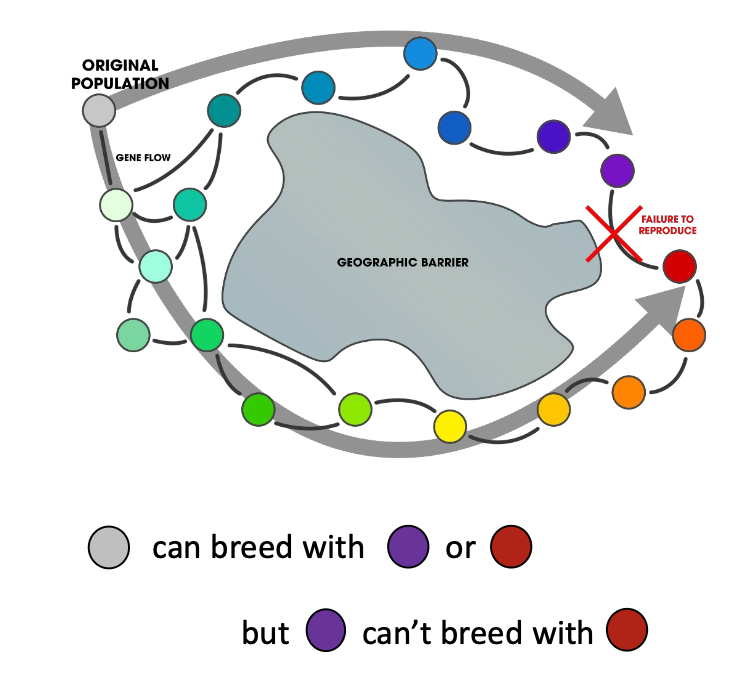
reproductive barriers
inhibit gene flow so that new species develop
reproductive isolation required - biological factors impede members of two species from interbreeding, limit the formation of hybrids, effectively isolate a species’ gene pool
two types: pre-zygotic and post-zygotic mating barriers
pre-zygotic reproductive barriers
prevents successful production of a zygote
no mating attempted types
temporal isolation - some aspect of reproductive cycle occur at different times (day/night, seasons, etc) between species
habitat isolation - different preferences in habitat or requirements for reproduction (one breeds in shallow puddles/creeks vs. in large pools/streams)
behavioral isolation - some behavior/behavioral preference prevents attraction/mating (unique mating calls only attract females of one species)
mating attempted, no zygote formed
mechanical isolation: morphological features (e.g. genetalia) physically prevent successful mating
gametic isolation: gametes do not unite (types of sea urchins release zygotes into water all at once, sperm and eggs have specific recognition molecules needed to form a zygote that are only present in the same species)
post-zygotic reproductive barriers
prevents viable offspring; mating and fertilizaiton occur and zygote forms
hybrid inviability: development of the hybrid zygote is impaired; hybrid is frail and doesn’t complete development
hybrid sterility: hybrid zygote develops, but cannot reproduce (mules are horse/donkey cross, ligers: can all develop fine but are infertile
hybrid breakdown: hybrid develops, can reproduce initially, but subsequent generations are weak or sterile, more common in plants (1st gen is fertile, 2nd gen is feeble or sterile)
process from speciating to distinct species

mechanisms of speciation
allopatric speciation: geographic separation, preventing gene flow
natural selection and genetic drift → populations diverse
reproductive isolation
means that regions w/ more geographic barriers will have more species - the reason endemic species are common on islands
sympatric speciation: without geographic isolation
requires that a reproductive barrier evolves first
polyploidy: one mechanism that can lead to sympatric speciation (uncommon in areas, common in plants): instant speciation event
how much genetic change needed for speciation?
impossible to generalize - speciation can be caused by cumulative divergence of many genes or just one or two changes
macroevolution
development of many new species over geological time - modern biodiversity
changes in diversity of life causes
intrinsic properties of the species
large-scale changes in climate or environment
can compare the fossil record to paleoclimate to see trends of climate events and loss of biodiversity events
“gap” in fossil record
often can’t see all the fossil record due to erosion - hard to tell how fast speciation occurs
gradualism
slow and steady change, mechanism by which speciation occurs
how most species develop
supported by studies of microevolution, population genetics
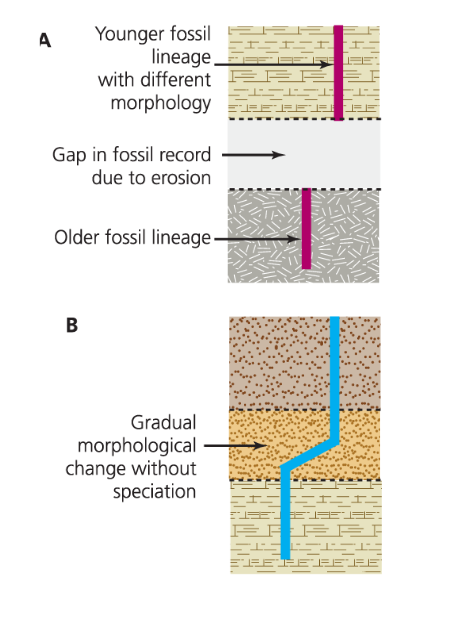
punctuated equilibrium
other theory of how speciation occurs
less common than gradualism, but happens!
periods of little change interrupted by short periods of rapid change
supported by polyploidy, antibiotic resistance
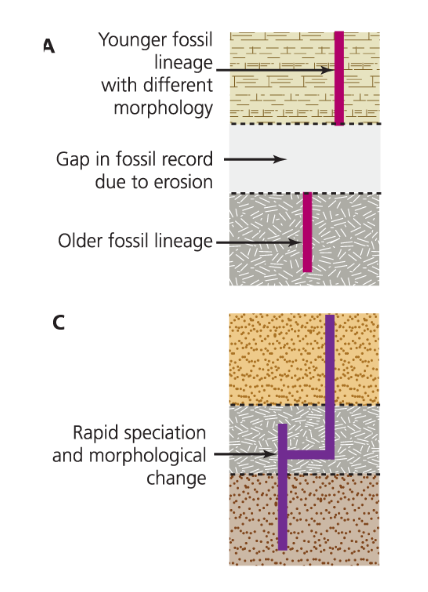
adaptive radiation
periods of rapid speciation, amny new species arive
often when there’s an ecological niche to fill
release from competition, predation
after a mass extinction
evolution of a key adaptation (hard body parts like jaws, shells), ability to breathe air and survive on land, flowers
and subsequent specialization
most involve exploitation of changes in environments not occupied by competitors
using key innovations via microevolution
adaptive radiation of mammals
after the extinction of dinosaurs, left ecological niche
mass extinctions
high rate of extinction compared to background rate, triggered by environmental change
5 major mass extinctions (6th now)
Permian-Triassic Extinction
largest mass extinction
changes in climate due to rapid increase of CO2 and CH4 (believed to be caused by volcanic activity) → heating and acidic oceans
96% of all life perished
Cretaceous-Paleogene Extinction
dinosaurs
(start of 01)
evolution
unifying concept of all biology, needed to understand: origin and diversification of life, disease, behavior
heritable change in a population across many generations
ecology
biology on the scale of interactions between organisms and their environments
microevolution
small-scale evolution causes change in a single gene and leads to the existence of different traits in a population
macroevolution
large-scale evolution causes change above the species level and leads to different species
evolution of evolutionary thought
First was Divine Creation: species are permanent and life is unchanging
Plato: every organism was perfect essence created by God, unchanging
Aristotle: Scala Naturae (a species hierarchy from imperfect to perfect, starting with inanimate matter and then “lower plants”, humans on top, without room for movement)
fossils provided evidence for change over time; best explanation for them is evolution
catastrophism
major disturbances cause change
Georges Cuvier
uniformitarianism
school of thought on evolution where gradual change over time due to natural processes
Charles Lyell
Jean-Baptiste De Lamarck
first to propose a mechanism for how life changes over time: inheritance of acquired characteristics (INCORRECT)
Charles Darwin
evidence: observations of thousands of species on sea voyages, fossil resembling living S American organisms, greater similarity within continents than within climates, deposits of marine shells found far above sea level (related slow changes in the Earth w/ slow changes in animals, diversity of life (bill shapes of finches on Galapagos Islands were adapted to their specific diet and means of gathering food)
extant
modern-day, currently living
endemic
species unique to a defined geographic location
Alfred Russell Wallace
independently developed theory of natural selection at same time as Darwin
Descent with modification
species present today descended from ancestral species
natural selection
mechanism responsible for change in a species over time
sources of genetic variation
mutation (creates new alleles), sexual reproduction (new combinations of alleles)
fitness
probability of surviving and reproducing in a given environment
surviving, finding mate, reproducing
inherited traits contribute to this, individuals with higher fitness tend to have more offspring
evolution
increasing frequency of favored traits in a population
natural selection
differential survival and reproduction of individuals due to differences in traits
leads to evolution
evidence for evolutionary change
artificial selection: shows how change occurs
homology
analogous structures
biogeography
fossil record
artificial selection (selective breeding)
purposeful selection for traits - pugs, Darwin’s pigeons (he argued that selection for their traits was analogous to what happens in nature)
homologous structure
some ancient structure becomes modified in different ways depending on lifestyle/environment → functionally different features with similar construction due to common ancestry
human arms, cat legs, whale fins, and bat wings all have the same types of bones
vestigial structures
anatomical features without function, resemble structures of presumed ancestors
human appendix, wisdom teeth, body hair, tiny femurs of whales and snakes
molecular homologies
similar molecular composition of proteins, DNA
embryonic homologies
similarities in embryonic life stage across species
due in part to molecular homologies
analogous structures
like an analogy - similar but no common ancestor
evolved independently for the same purpose, same or similar function
eg. bird, bat, bug winds
result of convergent evolution Isimilar structures in distant organisms with similar environments)
eg. carcinization (evolution of a crab-like body, has happened at least 5 separate times)
biogeography
geographic distribution of species
similarities between species separated by huge distances or impassable borders like an ocean indicate a common ancestor when land masses were together
species on ocean islands
resemble species of nearest mainland, wven if environment is different, don’t resemble species on island with similar environments in different parts of the world
fossil record
similarities between extinct and extant species with notable differences like size
Snider-Pellegrini-Wegener fossil map
shows plant and animal distributions across Pangea, explains how similar fossils are found across oceans
what are the units of evolution?
population
population
localized group of individuals that can interbreed, produce fertile offspring
microevolution
generation-to-generation change in allele frequencies in a population
changes in gene pool (sum of alleles in a population)
genetic drift
chance events cause allel frequencies to fluctuate unpredictably from one generation to the next
most important in small population, can greatly reduce or even eliminate alleles
fixed allele
when only one allele remains in a population
no variation → no natural selection
founder effect
individuals are isolated from the main population (can have loss of alleles, increase of frequency of rare alleles)
bottleneck effect
population goes through period of size decrease - loss of lots of individuals and their alleles
population later increases, but genetic diversity is low
ecological hierarchy
organismal, population, community, ecosystem, landscape, biosphere/global
organismal ecology
how physiology and behavior meet the challenges of an organism’s environment
landscape ecology
controls on the exchange of energy, materials, organisms across a mosaic of connected ecosystems
abiotic factors
non-living factors that determine where a population/species is found: environmental or climatic, can be geological, physical, etc
for terrestrial organisms: climate has strongest effect
temperature and precipitation
for aquatic organisms: light and nutrient availability
biotic factors
living factors that affect where a population lives
competition, predation, pathogens
a species’ potential range is determined by
tolerance to abiotic factors; wide for some species, narrow for others
a species’ distribution is determined by
a combo of biotic and abiotic factors; populations may not be found in some suitable areas because of predation, etc
abiotic factors limit ___ and biotic factors limit ___
the potential range of organisms; the actual distribution of organisms within those ranges
population ecology
dynamics of species populations and how they interact w/ the environment
population
group of indiv. of the same species that live in the same area
characteristics: density, dispersion, population structure (make-up of individuals: age and sex distribution), population rates
sex ratio
primary: at fertilization
secondary: birth/hatching
tertiary: later stage (adult)
becomes more skewed over time
hypotheses for skewed tertiary sex ratio
reproduction-related stresses (battles for reproduction, care for offspring)
dispersal (leaving the nest increases risk of predation)
intraspecific competition for dominance status, energetic requirements
age structure diagrams
predict future growth trend in humans, highlight future socio-economic conditions
pyramid (growing), bell (dome) shaped (stable), urn shaped (declining)
population rates
birth rate (b) (# births/population)
death rate (d)
fecundity (# of offspring/time per female), generally limited by # of gametes
generation time: time period from birth of individuals to birth of their offspring
generation time relation to body size
smaller body size trends with shorter ge
survivorship
tracks changes in # of individuals in a cohort over time
life table
summarizes the survival and reproduction rates of individuals in specific age groups, follows a cohort of individuals from birth til death
for sexually reproducing species, only the females are often followed/studied (they produce the offspring)
used to construct a survivorship curve
survivorship curve
proportion of individuals alive at each age
generally one of three types
differences are based on death rates during different life stages
Type 1 survivorship curve
late loss; high survival of offspring, high mortality later in life, females produce few offspring, high parental investment in care, many large mammal species
Type 2 survivorship curve
constant loss: mortality relatively constant across all ages (constant proportion dying at each age), common in rodents, invertebrates, lizards, annual plants
Type 3 survivorship curve
early loss: low survival of offspring, low mortality of adults, females produce many offspring, often no parental investment in care, common in long-lived plants, marine invertebrates, fish, sea turtles
r-strategists
live fast, die young
many small offspring, no parental care, fast growth rate, young at first reproduction
Type III, pyramid shapes, fast/exponential growth rate
K-strategists
slow and steady
few big offspring, lots of parental care, slow growth rate, delayed first reproduction
Type I, bell/urn shaped, slow/logistic growth rate
examples in between extremes of r and K strategists
trees and turtles (many small offspring, no parental care, slow growth, late reproduction)
change in population size
births + immigrants - deaths - emigrants
births - deaths
convert to instant in time … r = change in population
different between populations
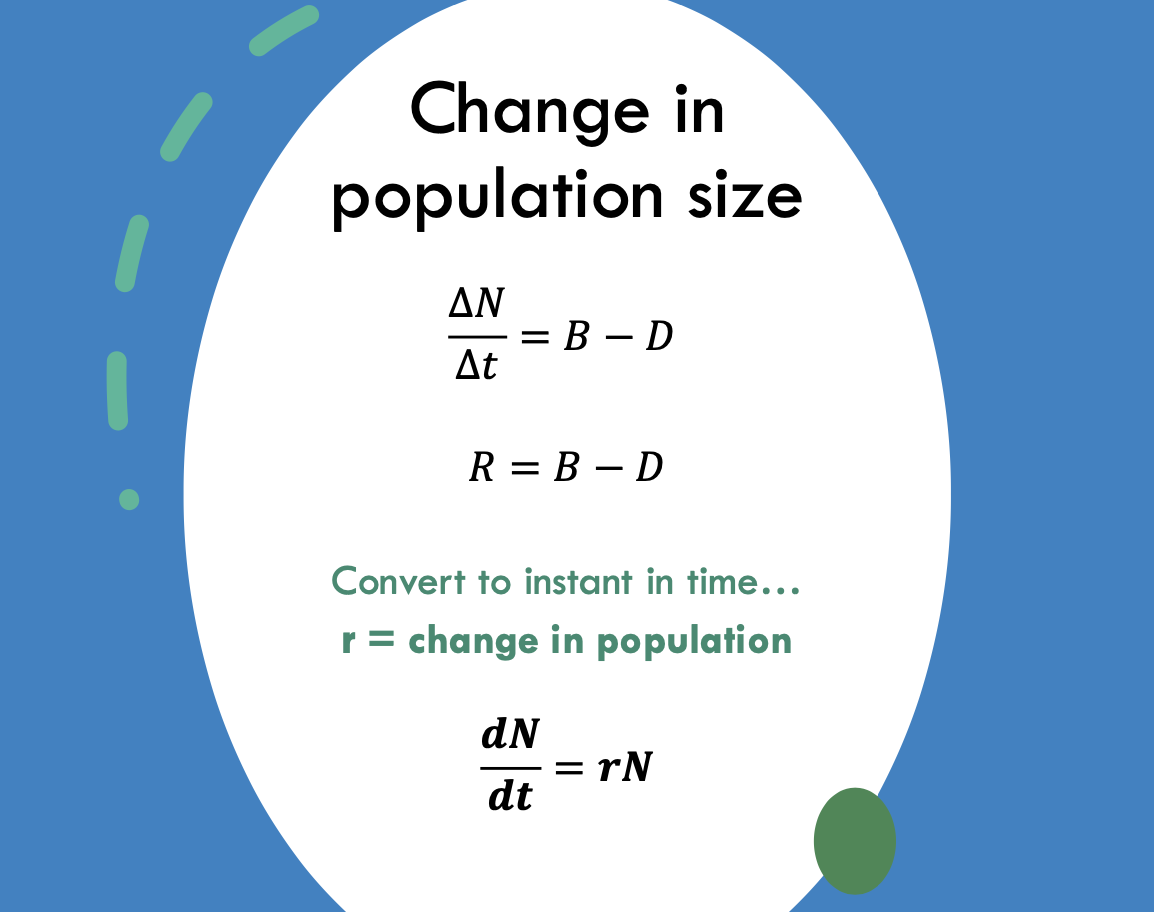
exponential growth
resources are abundant (ideal conditions) and no limits to pop growth —> free to reproduce at physiological capacity
r is the intrinsic rate of increase: per capita rate at which an exponentially growing population increases in size at each instant in time
small if there’s a high death/low birth rates
larger r, faster the population grows
N = # individuals in pop at given time
the larger N is, the faster the population grows
density-dependent population limiting factors
effect on population growth depends on population density
biotic factors - resource availability, predation, competition, infectious disease, etc
can be related to abiotic/independent: larger population density increases ability to resist environmental stress
density-independent population limiting factors
density not important; proportional effects
effect on population size is unpredictable
abiotic factors: weather/climate, disturbances, natural disasters, soil pH, etc
effects on populations when limits set in
possibly crash (risk esp. on islands)
can stabilize
logistic population growth model
idealized population growth that is slowed by population limiting factors as the population size increases
growth with constraint
slows as population size reaches carrying capacity
growth rate small when population is large or small, highest when population is at intermediate level relative to K
population grows exponentially at low population
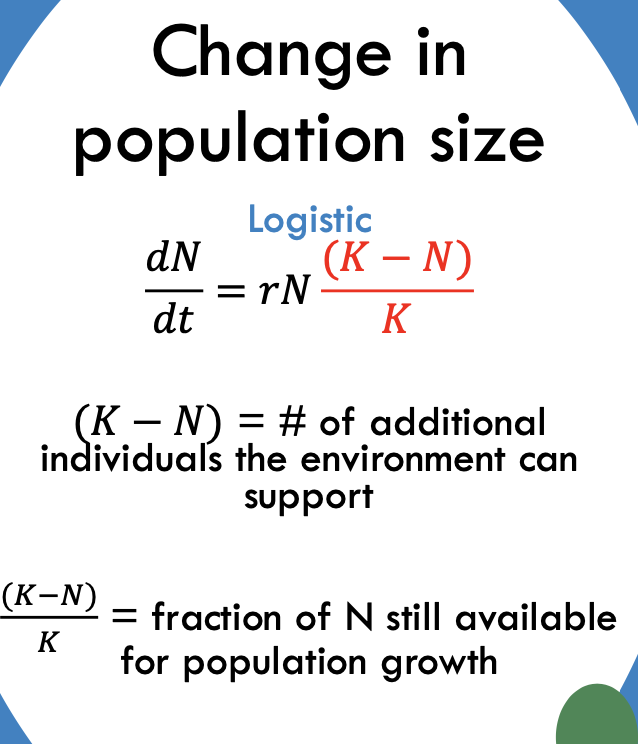
carrying capacity (K)
maximum population size a particular environment can sustain
changes w resources → varies over space and time
community
all populations of organisms living close enough together for potential interaction
interspecific interactions
predation, symbiosis (mutualism, commensalism, parasitism), competition
exploitation
(+ / -)
predation and herbivory